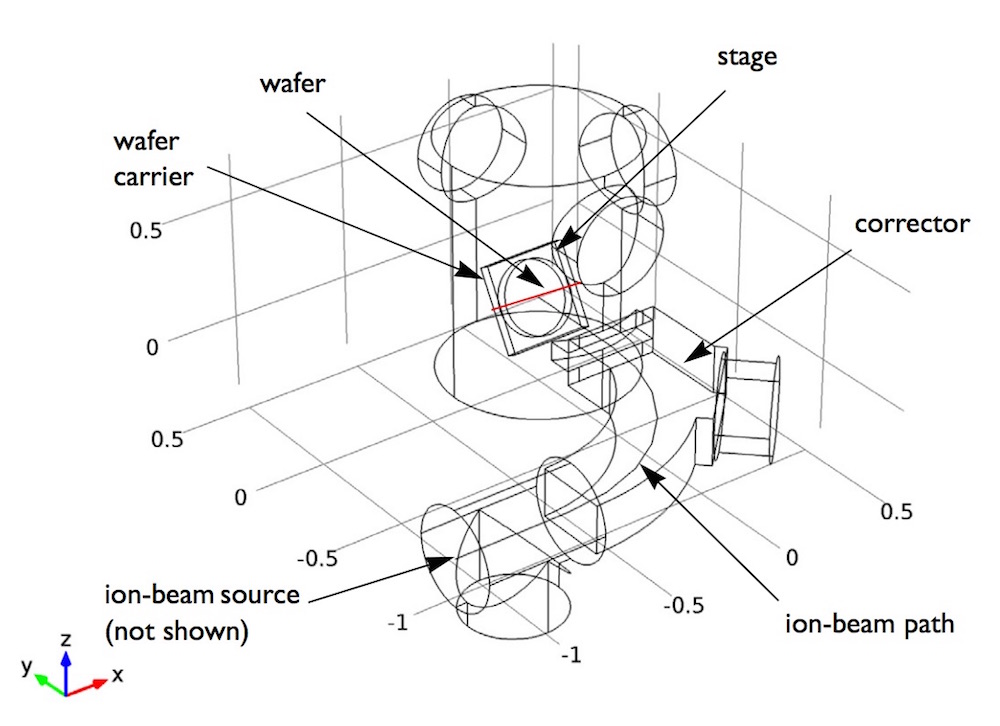
The semiconductor industry uses ion implanters to implant dopants into wafers. To optimize the design of these devices, engineers need to quickly and easily test a wide range of parameters. Simulation apps help streamline the design process of ion implanters by sharing the capabilities of a simple and fully customizable interface with colleagues who don’t have a simulation background. Here, we introduce you to our Ion Implanter Evaluator demo app.
Achieving Key Parameters to Avoid Undesired Effects
Known as doping in semiconductor device fabrication, ion implantation involves using an electric field to accelerate ions generated within an ion source to achieve a desired energy for successful implantation. For ions of a certain charge-to-mass ratio to reach the wafer, a selection magnet chooses ions of the correct charge state and bends the ion beam. In addition to ensuring that only certain ions reach the wafer, only specific parts of the wafer should be implanted. An organic photoresist is used to mask parts of the wafer and create the desired pattern.
One common issue with ion implanters is that when struck by the ion beam, the photoresist emits gas molecules of its own. When these outgassing molecules interact with the ion beam, it results in undesirable charge-to-mass ratios at different points along the path of the beam. If the molecules reach the wafer, it degrades the uniformity of the implant and affects the accuracy of the measurements for implant doses. To avoid this issue, the number density of the outgassing molecules should remain as low as possible within the ion beam line.
By transforming this model into an app, you can evaluate key parameters to ensure that these undesirable effects are avoided. The simple, intuitive interface of an app provides colleagues with the ability to make their own changes to your ion implanter simulation.
A Demo App for Analyzing an Ion Implanter Design
The Ion Implanter Evaluator simulation app is based on our Ion Implanter Evaluator tutorial model, created with the Molecular Flow Module. The ion implanter includes a wafer held on a carrier plate that can rotate its center axis to create different angles for implantation. The plate is positioned in a chamber with three large cryopumps placed on cylindrical vacuum ports. The device also features a vacuum path through the magnetic field that enters the main chamber opposite the wafer. There’s an additional cryopump at the beginning of the beam path and an aperture at the entrance of the chamber that reduces flux in the connector.

Model geometry of an ion implanter.
The user interface for the ion implanter demo app contains a range of simple tools designed to be used by simulation engineers and non-simulation experts alike. The ribbon contains different buttons that you can use to solve the app, such as:
- Reset to Default Values, to reset your input parameters
- Compute, to solve your study
- Read Documentation and Create Report, to further evaluate the input parameters
There are also fully customizable forms, shown on the left side bar, which allow you to:
- Enter the model geometry and conditions
- Select which plot to display
- View numerical outputs and model information

The simple user interface for the Ion Implanter Evaluator demo app.
The parameters for the model above can be easily and repeatedly changed by both you and your colleagues. You are able to test the angle of the wafer to find optimal placement to keep the number density of the outgassing molecules low, and therefore preserve the uniformity of the wafer. Other possible parameter adjustments include:
- Molecular weight of the outgassing species
- Outgassing rate
- Surface temperature
- Pump speeds for cryopumps
By creating your own ion implanter app, you can include all or some of these parameters, as well as a range of other possibilities based on your own simulation needs. You can easily visualize the results of your parameter inputs on the right side of the screen. In our demo app, we are able to view the number density, pressure, molecular flux, and the average number density along the beam line to start evaluating and optimizing the ion implanter.
Ensuring that you are able to model an ion implanter with optimal performance will aid in more efficient and reliable semiconductors.
Get Started Building Simulation Apps
- Download the Ion Implanter Evaluator demo app
- Read more blog posts about how to create simulation apps and why you should join the simulation revolution
- See the new and updated features in the Application Builder that are available with COMSOL Multiphysics version 5.1




Comments (0)